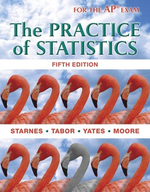Solution Found!
Young Adults' TV Habits: Decoding Mean and Probability
Chapter 8, Problem 79(choose chapter or problem)
Choose a young person (aged 19 to 25) at random and ask, “In the past seven days, how many days did you watch television?” Call the response X for short. Here is the probability distribution for X:
\(\begin{array}{lcccccccc} \hline \text { Days: } & 0 & 1 & 2 & 3 & 4 & 5 & 6 & 7 \\ \text { Probability: } & 0.04 & 0.03 & 0.06 & 0.08 & 0.09 & 0.08 & 0.05 & ? ? ? \\ \hline \end{array}\)
(a) What is the probability that X = 7? Justify your answer.
(b) Calculate the mean of the random variable X. Interpret this value in context.
(c) Suppose that you asked 100 randomly selected young people (aged 19 to 25) to respond to the question and found that the mean \(\bar{x}\) of their responses was 4.96. Would this result surprise you? Justify your answer
Questions & Answers
QUESTION:
Choose a young person (aged 19 to 25) at random and ask, “In the past seven days, how many days did you watch television?” Call the response X for short. Here is the probability distribution for X:
\(\begin{array}{lcccccccc} \hline \text { Days: } & 0 & 1 & 2 & 3 & 4 & 5 & 6 & 7 \\ \text { Probability: } & 0.04 & 0.03 & 0.06 & 0.08 & 0.09 & 0.08 & 0.05 & ? ? ? \\ \hline \end{array}\)
(a) What is the probability that X = 7? Justify your answer.
(b) Calculate the mean of the random variable X. Interpret this value in context.
(c) Suppose that you asked 100 randomly selected young people (aged 19 to 25) to respond to the question and found that the mean \(\bar{x}\) of their responses was 4.96. Would this result surprise you? Justify your answer
ANSWER:Step 1 of 3
(a)
Add all known probabilities:
\(0.04+0.03+0.06+0.08+0.09+0.08+0.05=0.43\)
The sum of all probabilities should be equal to l, thus the missing probability is 1 decreased by the sum of all known probabilities.
\(P(X=7)=1-P(X \leq 6)=1-0.43=0.57\)
Watch The Answer!
Young Adults' TV Habits: Decoding Mean and Probability
Want To Learn More? To watch the entire video and ALL of the videos in the series:
Discover how to determine the probability and mean of young adults watching TV in a week. Using provided data, we compare the sample mean with the calculated population mean to interpret expected TV viewing habits.
